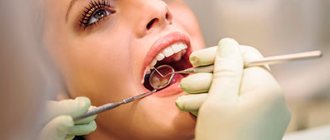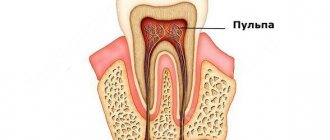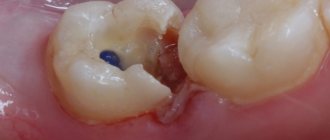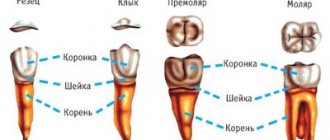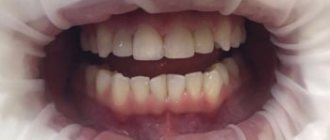Removing the nerve or pulp of a tooth is a procedure that can only be done if there are serious indications. For example, if there is severe inflammation or it is impossible to save a tooth without depulping.
- Pulpitis. Often develops against the background of advanced caries. The carious process destroys the enamel gradually. If you go to the clinic in a timely manner, it is not difficult to cure your tooth. In advanced cases, the pulp chamber begins to collapse, and then the pulp becomes inflamed. Inflammation that affects the nerve of the tooth leads to the development of pulpitis. With this disease, it is most often possible to save the tooth only if the nerve is removed. In the early stages of pulpitis, partial removal of the inflamed nerve is possible. This allows you to stop inflammation and at the same time preserve part of the pulp. After surgery, the tissues of such a tooth will continue to receive nutrients, so partial removal of the nerve has advantages over complete removal. The volume of the nerve to be removed will be determined by the doctor based on the diagnostic results.
- Injury. Traumatic pulpitis can develop for various reasons. The most common is a strong blow and destruction of the tooth crown. Dental treatment, for example, deep caries, can also damage the pulp chamber. To drill out all the damaged tissue due to deep caries, the doctor requires experience and almost jewelry work. An inexperienced dentist can damage the pulp chamber during drilling, which can result in traumatic pulpitis. To save a tooth, the nerve often has to be removed after severe trauma to the tooth.
- Retrograde pulpitis. A rather rare disease in which the infection enters the pulp not from the crown, but through the apex of the root. The infection can be transferred to the root of the tooth by the bloodstream from other foci of inflammation: periodontal pocket, maxillary sinuses, etc. Retrograde pulpitis can also develop as a complication of various diseases - influenza, chickenpox, rubella, etc.
- Concretions. If there is a metabolic disorder, hard deposits can form in the dental canals. They put pressure on the pulp, causing permanent injury. As a result, pulpitis may develop over time. If stones are present, nerve removal is almost always required.
It is often necessary to remove the nerve before dental prosthetics. This usually happens when a patient with teeth severely damaged by caries comes to the orthopedist. The doctor will determine whether it is necessary to remove the nerve. If it is not practical to preserve the pulp, the doctor will prescribe removal of the nerve, cleaning and filling of the dental canals.
The orthopedist also evaluates the advisability of removing the nerve if prosthetics require extensive tooth preparation. If there is a risk of injury or overheating of the pulp during preparation, it is more advisable to remove the nerve and reduce the risk of developing inflammation under the installed crown. The doctor always determines the need for depulpation individually in each specific case.
Painless removal of a nerve from a tooth: how it goes and consequences
Many people are familiar with the procedure of removing a nerve from a tooth, which was accompanied by the mandatory placement of arsenic. Previously, this method took several days, during which the substance killed the nerve, after which the doctor removed the pulp and installed a filling or crown. Modern methods make it possible not to resort to arsenic, using more effective and painless methods. The pulp or neurovascular bundle performs important functions; it nourishes and protects tooth tissue from infection. Without it, the enamel changes color, hard tissues are destroyed faster, but in some situations, removal of the nerve is necessary.
What is a dental nerve
Under the coronal part in the root canals there is soft connective tissue penetrated by nerve endings, capillaries, and lymphatic vessels. It is called the pulp, colloquially the nerve. It performs a plastic, sensory, protective, trophic function.
If inflammatory processes occur and untimely therapy occurs, it may die. If it is impossible to preserve the pulp, amputation is performed. Removing the nerve of a tooth leads to fragility of hard tissues, but with correct treatment it will retain its functionality for many years.
Causes of dental pulp damage
The dentist is often visited because of caries - damage and destruction of enamel, which at the initial stage causes aesthetic discomfort.
Important: if the disease is started, the process affects the deeper layers of the tooth and pulpitis develops, that is, the neurovascular bundle becomes inflamed.
Pathologies arise due to the rapid proliferation of microbes, but in addition, the pulp can be damaged for the following reasons:
- gum disease, in which the neck of the tooth is exposed, the bone tissue is destroyed and harmful bacteria penetrate inside;
- trauma, as a result of which part of the tooth can break off, and then microbes enter the resulting cavity;
- mistake by the dentist who installed the filling or crown. If some actions were incorrect, then the nerve will make itself felt after a while.
These are the main causes of pulp damage. The symptoms of this condition will be acute. The pulp will begin to react to cold, hot, too spicy, sweet foods. Removing the nerve in such situations is a necessity, despite the fact that minerals and nutrients will stop flowing to the tooth.
Activities before visiting the doctor
If the tooth hurts and it is obvious that nerve removal cannot be avoided, you should immediately make an appointment with the dentist. To relieve pain in the period before your visit to the office, you can perform a number of manipulations. Pain can be reduced or relieved by:
- Carefully remove food debris from the cavity in the tooth.
- Rinse with warm soda solution.
- Avoid chewing food on the affected side.
- Minimize exposure to high and low temperatures (including cold air).
- Mouth slightly open. If the bite is incorrect, closing the jaws may increase the pain.
- Painkillers.
PROMOTION
Inexpensive dentistry
Prices are 1.5-2 times lower
Why do you need to remove the pulp?
We talked about the main reasons why nerve inflammation occurs, but most often pulpitis becomes a consequence of advanced caries. Therefore, it is very important to visit a dentist, even if nothing bothers you. The decision to remove the pulp is made in the following situations:
- pulpitis has passed into the stage of periodontitis, when inflammation affects the whole complex of connective tissue in the tooth;
- large area of carious lesion;
- the infection spreads through the apex of the tooth root;
- the appearance of unbearable, prolonged pain;
- spread of infection under an artificial crown;
- consequences of improper treatment.
The nerve can be removed either completely or partially, it all depends on the degree of tissue damage. Depulpation will prevent the spread of the inflammatory process under the crown and preserve the natural tooth, which is a priority for endodontic therapy.
The list of treatments for dental pulpitis includes:
| — Mechanical and medicinal treatment of 1 channel |
| — Pulpitis (simple) root canal filling with three-dimensional obturation system E&Q Plus (1k/k) |
| — Pulpitis (simple) root canal filling with three-dimensional obturation system E&Q Plus (2k/k) |
| — Pulpitis (simple) root canal filling with three-dimensional obturation system E&Q Plus (3k/k) |
| — Pulpitis (complex) filling of root canals with the E&Q Plus three-dimensional obturation system (1k/k) |
| — Pulpitis (complex) filling of root canals with the E&Q Plus three-dimensional obturation system (2k/k) |
| — Pulpitis (complex) filling of root canals with the E&Q Plus three-dimensional obturation system (3k/k) |
How does the pulp removal process work?
We mentioned the method using arsenic at the very beginning. Some dentists still use it. The disadvantages of this treatment include its duration and pain. Before administering arsenic, the doctor must widen the root canal and place the substance into it. He then seals the area with a temporary filling. After two days, the arsenic kills the nerve, then the dentist cleans the substance from the tooth cavity and removes the pulp.
Important! Arsenic should not remain longer than expected in the oral cavity, as it is a poison and can be destructive to tissue.
There are more modern ways of performing the procedure, which are both safer and more painless. Before any action, an x-ray is required, which shows the vitality of the pulp, the length of the canal and other features.
Pulp removal is carried out using the vital and devital method. The first option is used for patients of any age. Its stages are as follows:
- the tooth is exposed;
- the pulp is removed with a special tool - a pulp extractor;
- a filling is installed.
In some situations it may be temporary and after a few days it changes to permanent.
Note: all stages of treatment are performed under anesthesia, so they will not be painful or uncomfortable for the patient.
The devital method is similar to what was used ten or more years ago, only instead of arsenic, a non-toxic substance is installed in the tooth cavity. The main method of pulp removal in modern dentistry is the vital method, when in just 1 visit to the doctor you can undergo complete painless dental treatment.
Important: temporary pain after a dental procedure is considered normal, as tissue intervention has occurred. If severe pain does not go away within 3 days, you should consult a doctor.
Depulpation before prosthetic crowns
Depulpation is unconditional if there is serious tooth decay. It is preferable to remove the dental nerve during prosthetics in the following cases:
- The size of the teeth determines the low position of the crown (too small or short teeth);
- The inclination of the prosthetic tooth is from 15°;
- Increased sensitivity of teeth;
- According to aesthetic requirements.
The need to remove the dental nerve during prosthetics is dictated by deep removal of the top layer of dental tissue: if the doctor is not sufficiently qualified, heating or touching the nerve can cause an attack of unbearable pain. However, cases of nerve-sparing crown installation also occur in modern dental practice.
If over time the nerve under the crown becomes bothersome, it is possible to remove the pulp through the top of the crown and fill the hole after removal.
The danger of such a procedure is associated with the risk of complications in the future due to surgery on the exposed dental nerve.
In what situations should a nerve not be removed?
We are talking not only about contraindications, but also about cases in which the pulp can be preserved. The procedure is not performed if the patient has:
- any infectious disease;
- one of the forms of stomatitis;
- psychoemotional disorders;
- acute pathologies of the heart and blood vessels;
- unsatisfactory condition of the oral cavity with suppuration and inflammation.
The nerve is preserved if it is not subject to inflammation due to caries or other pathologies and injuries. The dentist’s task is to save the pulp and remove it only in case of emergency.
Important: you cannot endure a toothache and hope that the pain in your nerve will stop. Inflammation can become chronic and show almost no effect, but any provoking factor will affect the development of a purulent abscess. In this case, the minimal consequence will be tooth loss, and the possible consequence will be the spread of infection to other tissues.
Indications and contraindications for removal
Pulpitis is treated conservatively and surgically. If it is possible to preserve the pulp, the dentist tries to cure the disease with medications and physiotherapy.
The nerve must be removed in the following cases:
- if the carious lesion has spread to the canals and pulp;
- there is a concomitant disease of periodontitis (inflammation of the periodontium, which holds the tooth unit in the socket);
- severe damage to dentin by caries (large area, presence of several carious cavities);
- mechanical damage;
- the presence of concrements in the canals - hard deposits that cause irritation and inflammation of soft, sensitive tissues;
- lack of positive results from therapy;
- unbearable pain that cannot be relieved by medications.
Depulpation can also be carried out if the orthopedist indicates prosthetics.
The procedure is not performed if:
- stomatitis, acute infections, since pathogenic microorganisms can penetrate deep into the jaw and cause the development of serious diseases;
- poor blood clotting due to the risk of heavy bleeding;
- pregnancy due to the inability to provide the necessary anesthesia.
Consequences of nerve removal
If the treatment was carried out by a professional and experienced dentist, then apart from slight pain the patient will not be bothered by anything. Otherwise, there may be such complications:
- a fragment of the instrument remains in the dental canal;
- the nerve was partially removed;
- incorrect or poor-quality filling of the canal;
- mechanical damage to the root or wall;
- rapid darkening of the enamel;
- suppuration due to poor disinfection.
Important! Depulpation at the Crystal clinic is carried out with the minimum possible complications, since all procedures are carried out by certified doctors with extensive experience using high-tech equipment and tools.
After depulpation, it is recommended not to eat for 2-3 hours, not to eat cold, hot, hard or other foods that irritate the mucous membrane. Your doctor will tell you in more detail about the necessary actions after removing the nerve.
Anesthesia
Almost always, the nerve is removed under local anesthesia; usually, instead of the upcoming operation, the required dose of the drug is administered using a syringe. Immediately before the injection, the gums are treated with a special spray or gel containing an anesthetic, so even the slightest discomfort is eliminated. The needles used are as thin as possible.
There are several of the most common drugs used by dentists for pain relief: mepivacaine, ultracaine, articaine with epinephrine or pure. These products prevent the onset of pain; they are suitable even for people with chronic diseases, pregnant women and those prone to allergic reactions.
A gel with lidocaine is also actively used, which is placed around the diseased tooth. In this case, the patient feels as relaxed as possible and does not have any unpleasant sensations. In rare cases, pain may occur due to an incorrectly administered drug or due to the individual reaction of the patient's body. If you have a strong fear of dentists or serious psychological disorders, nerve removal can be performed under general anesthesia.


